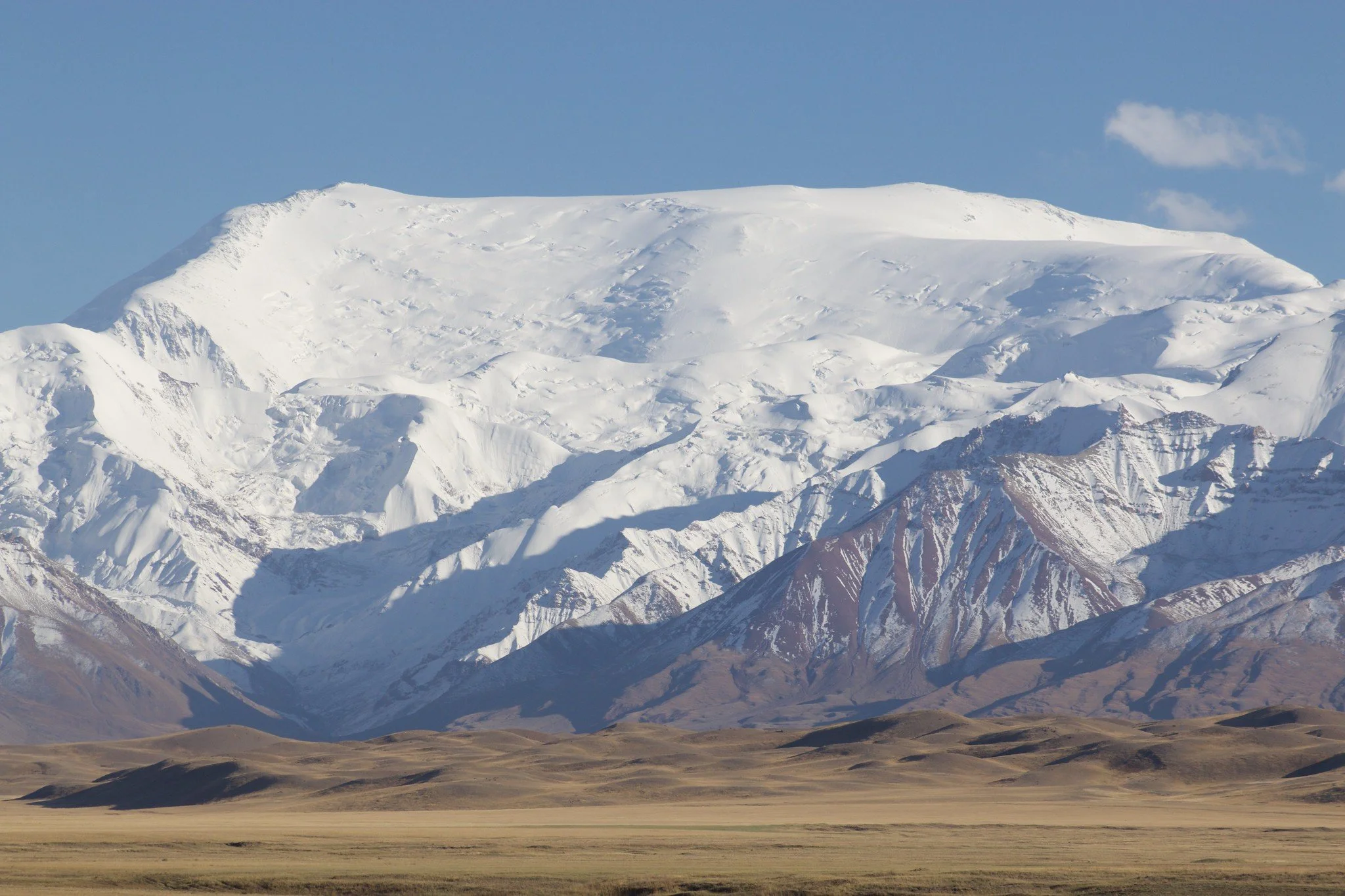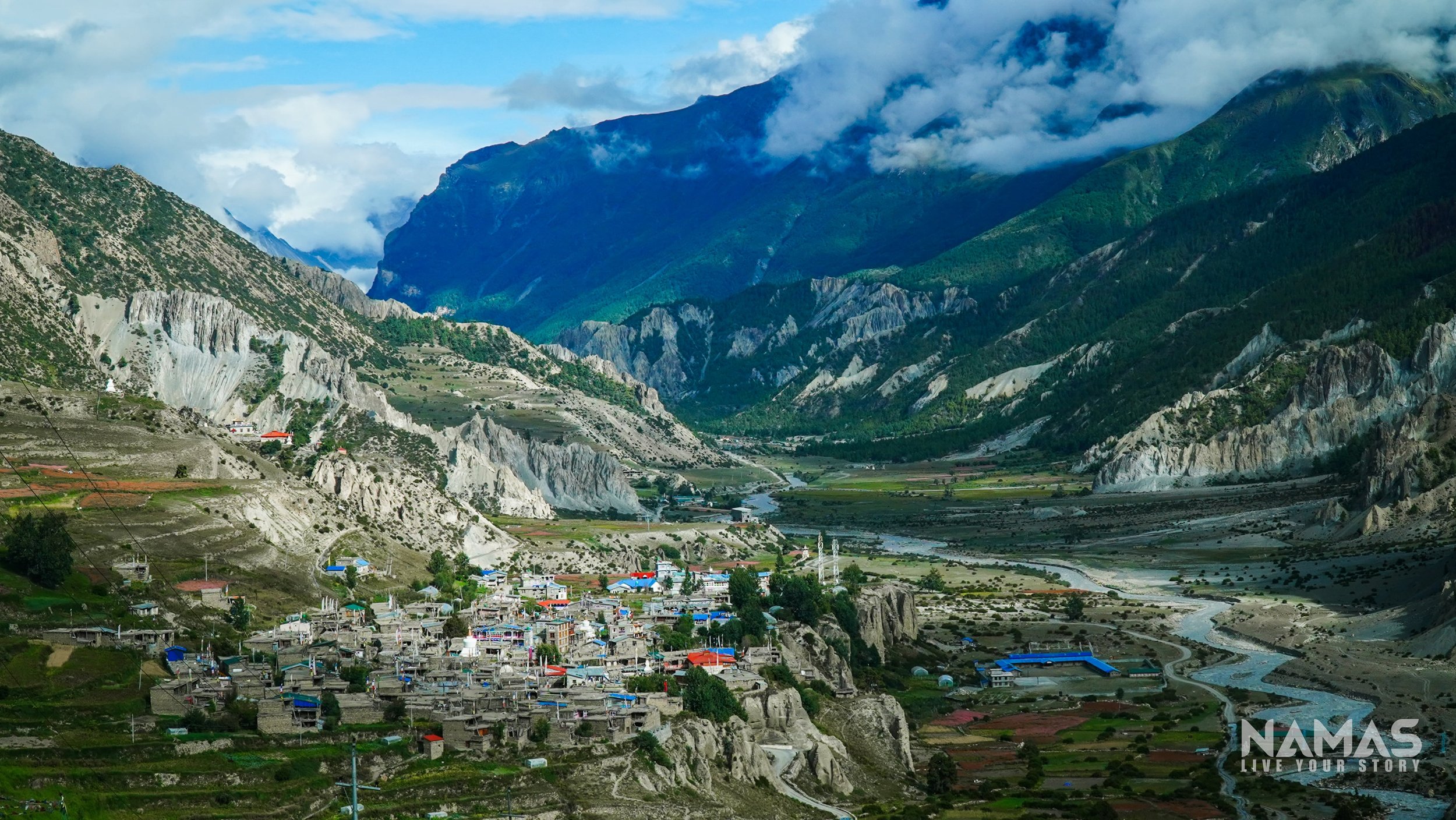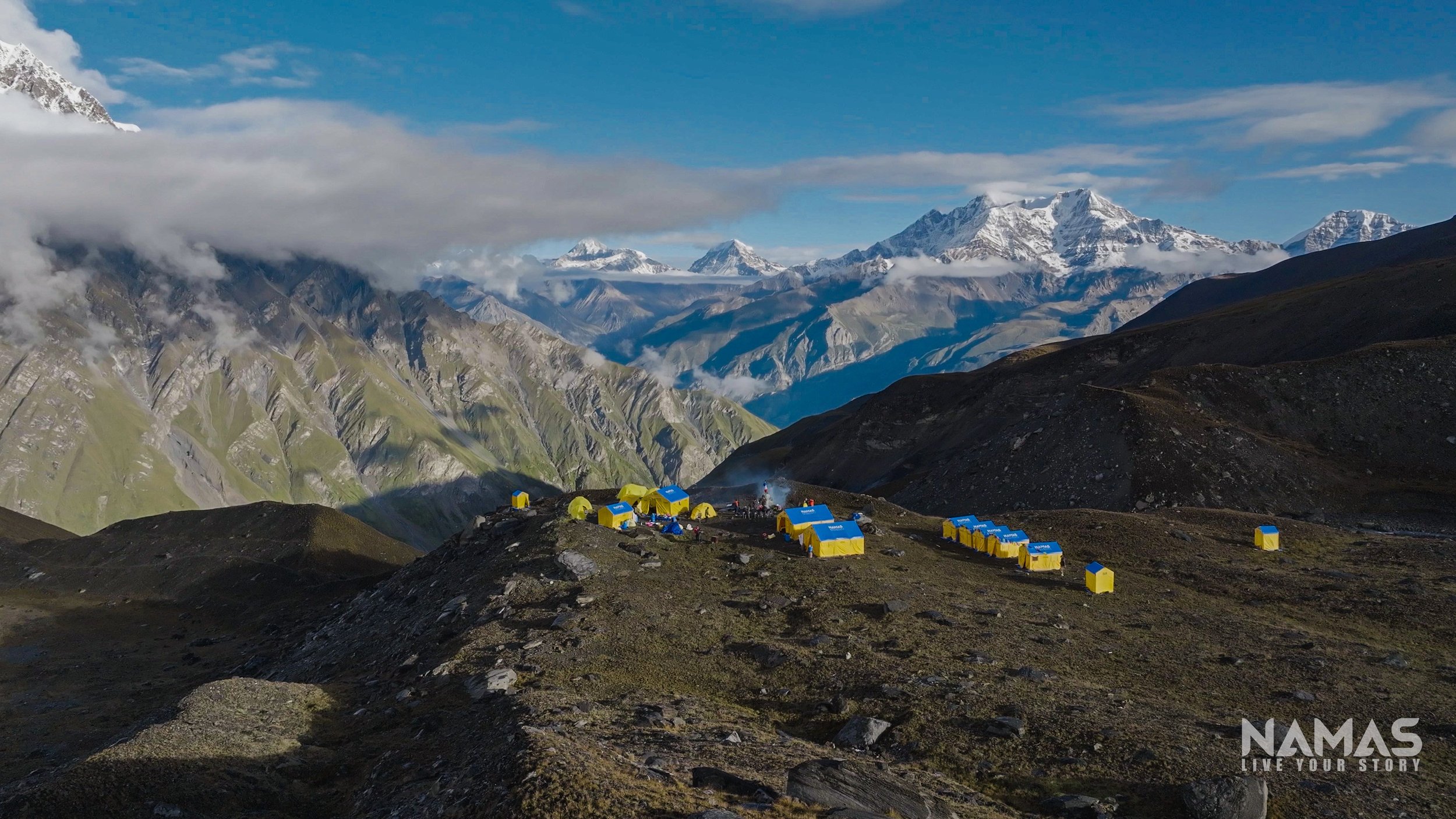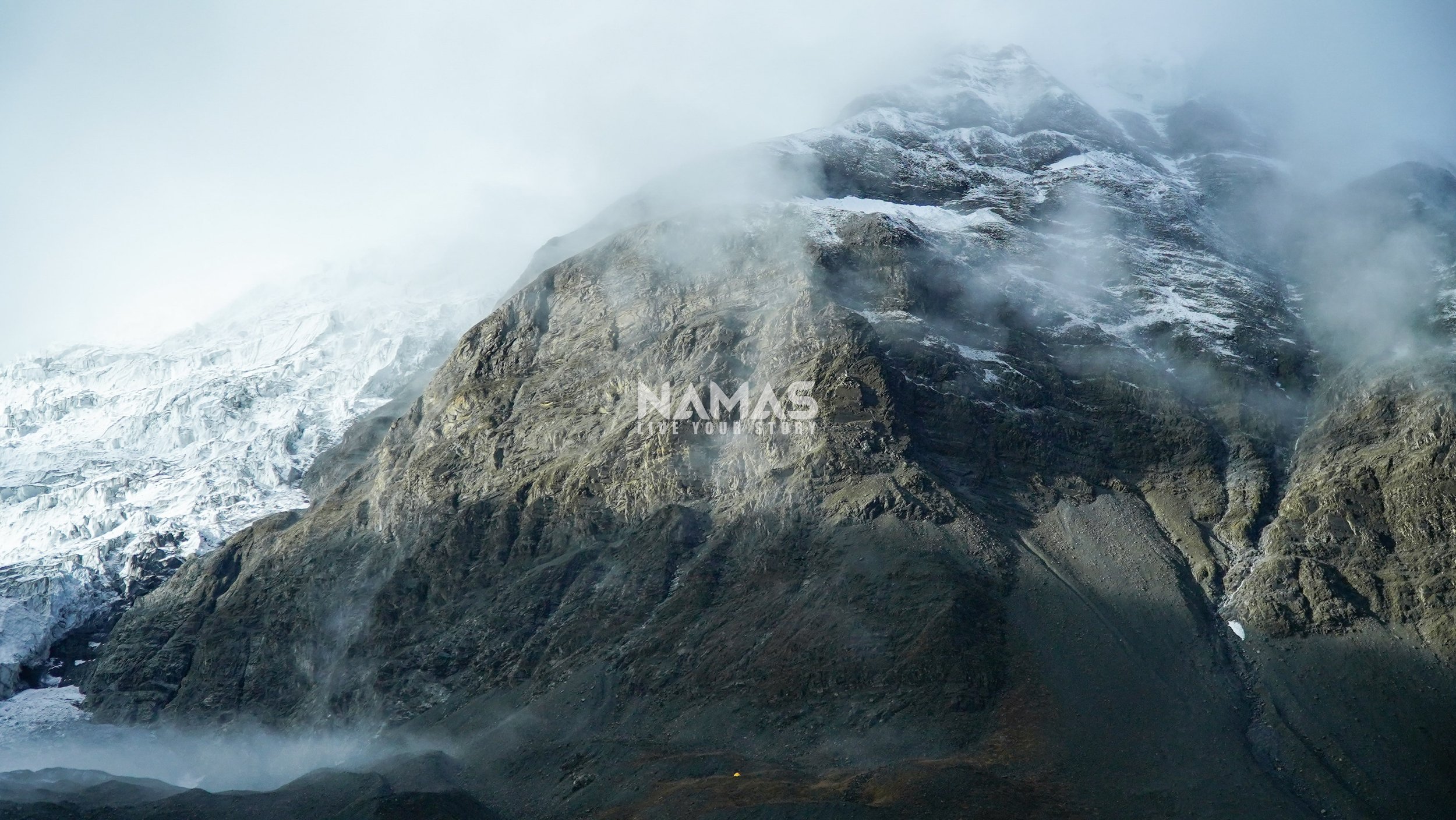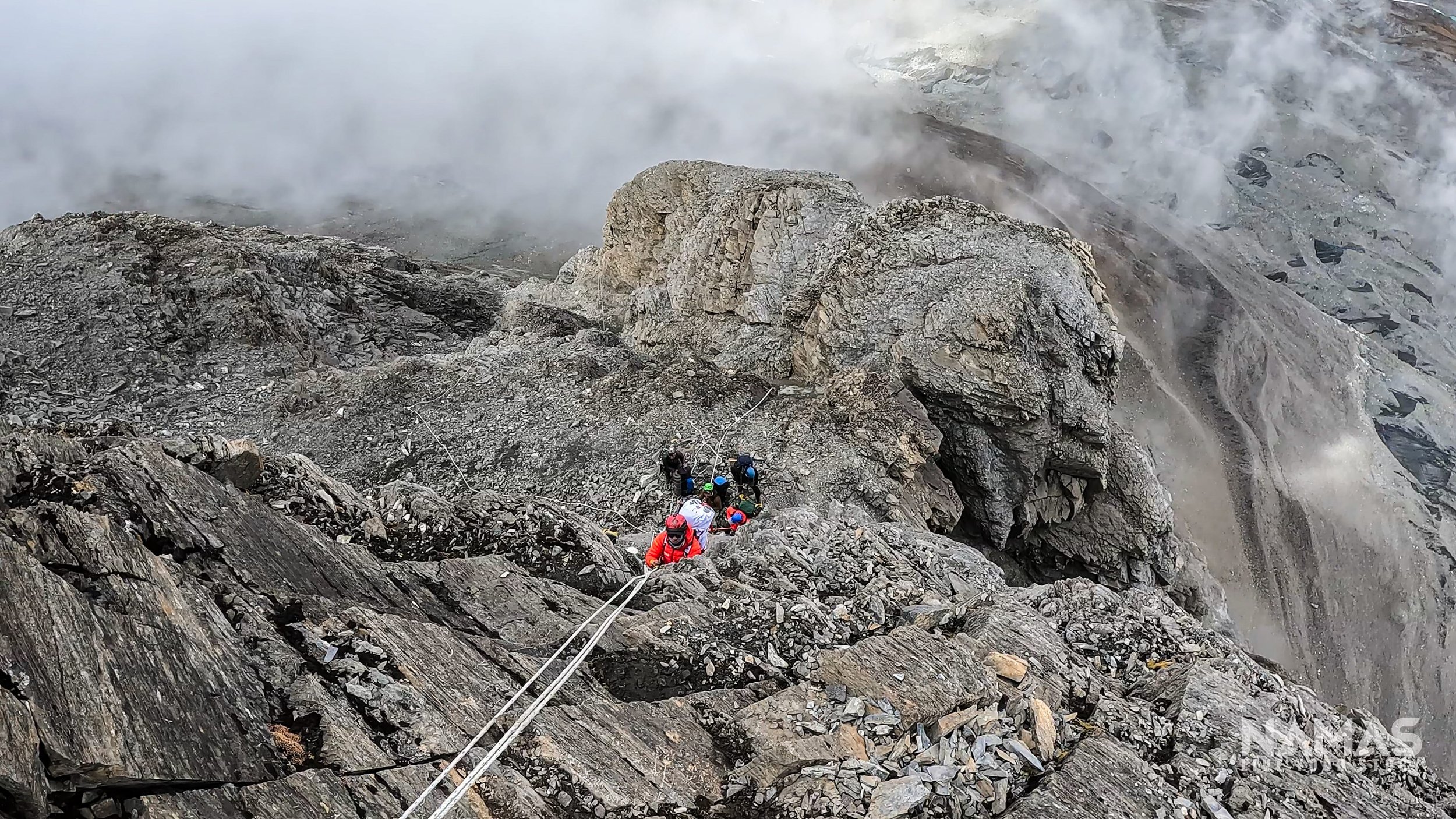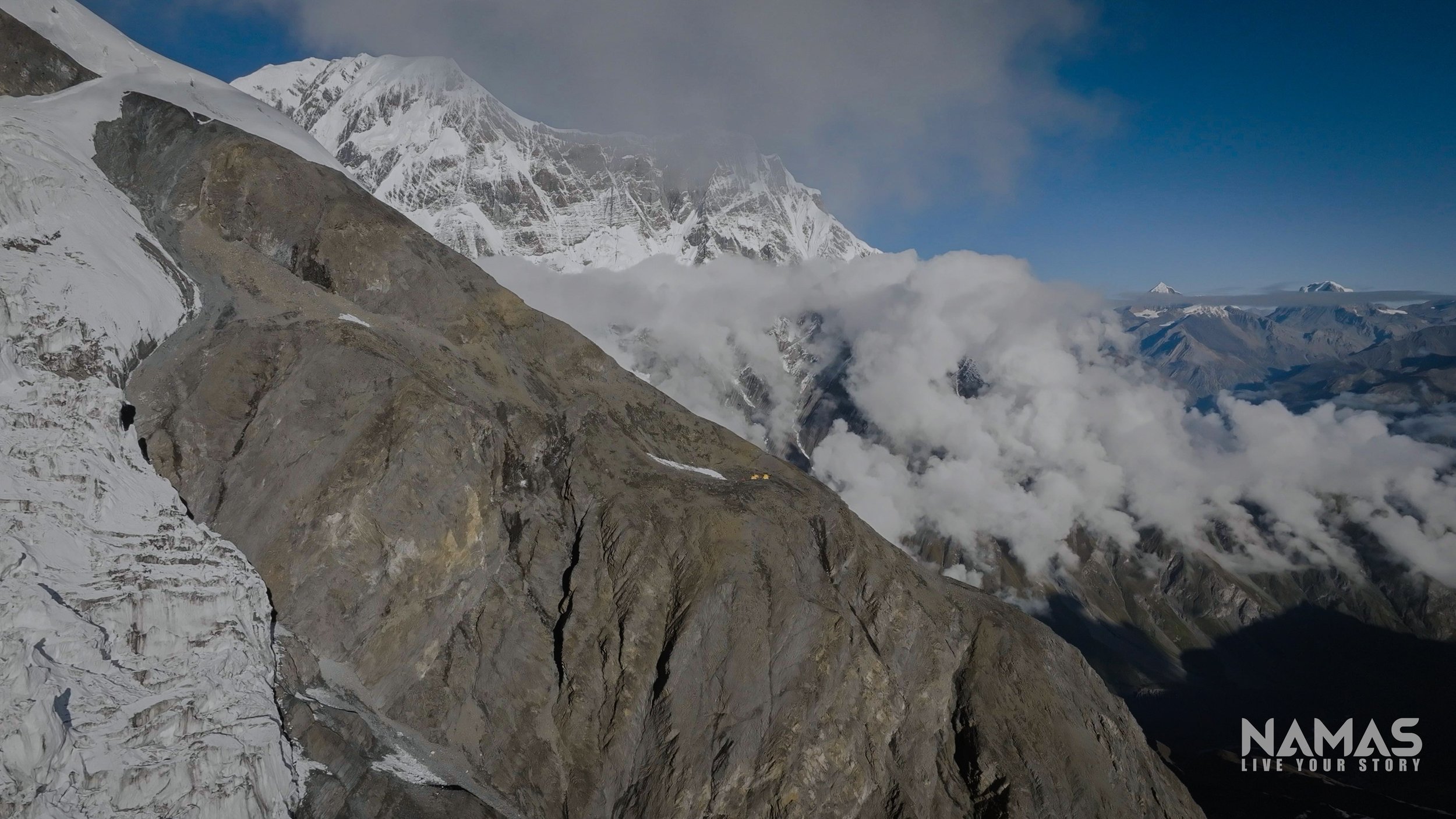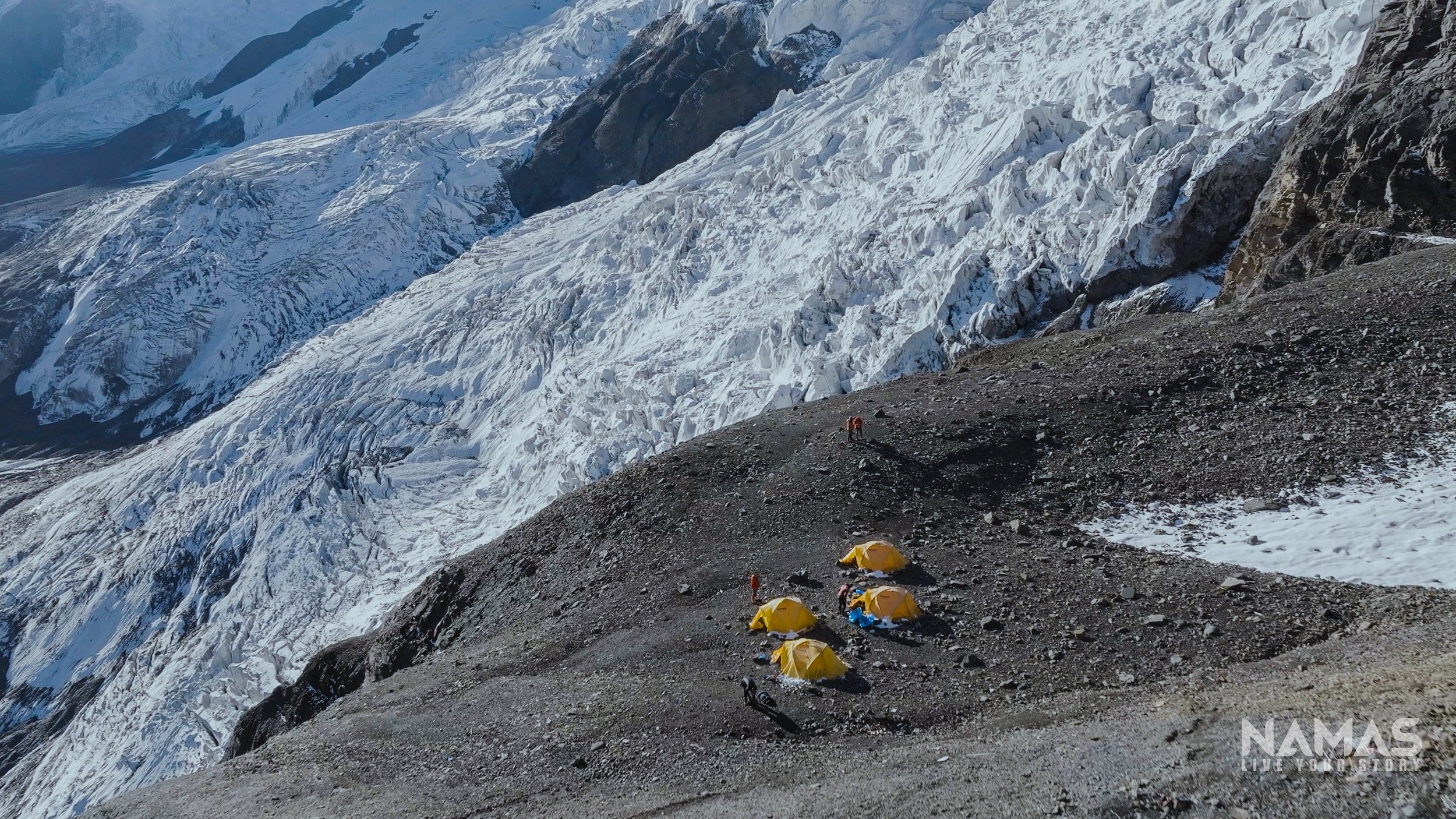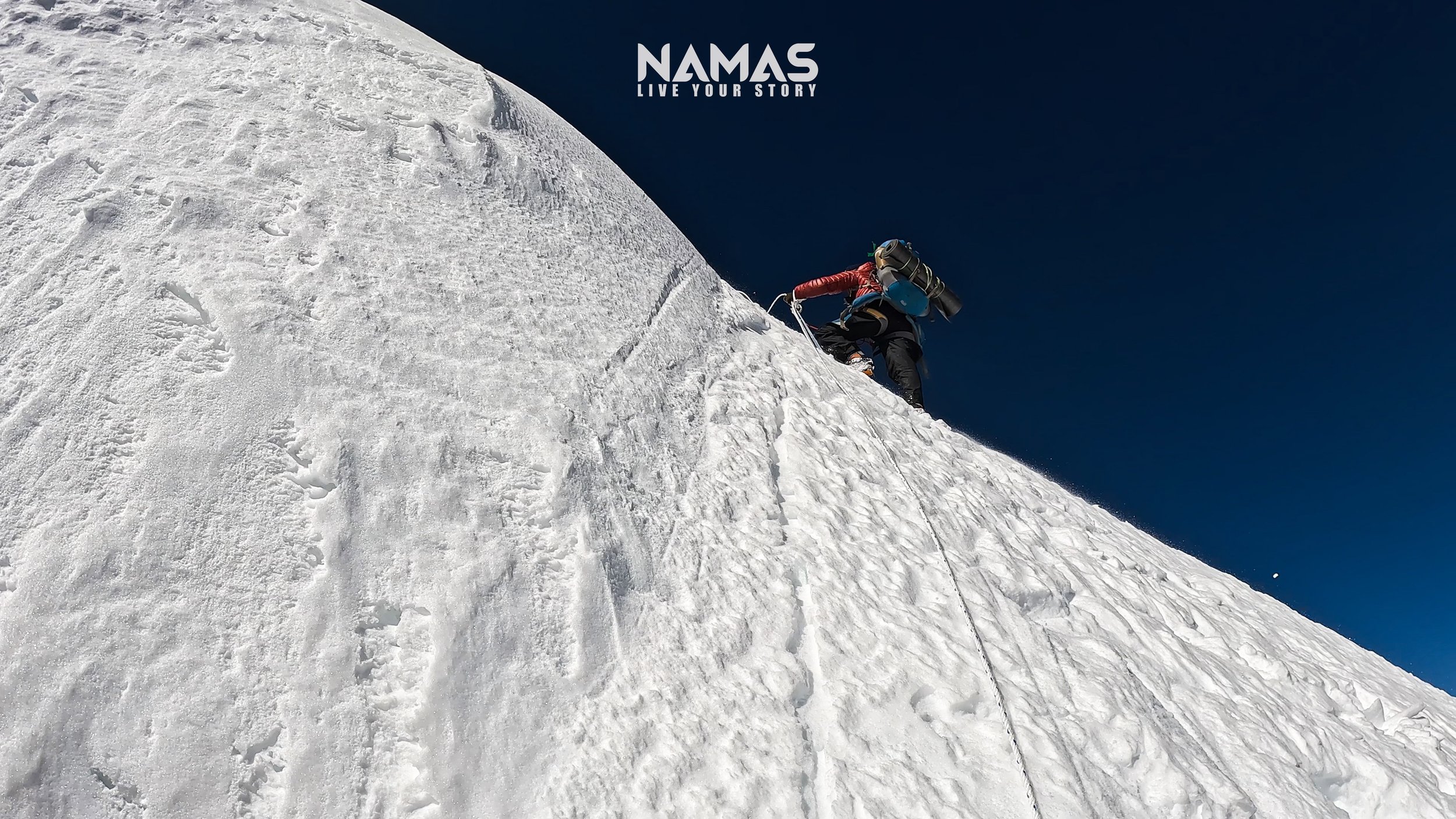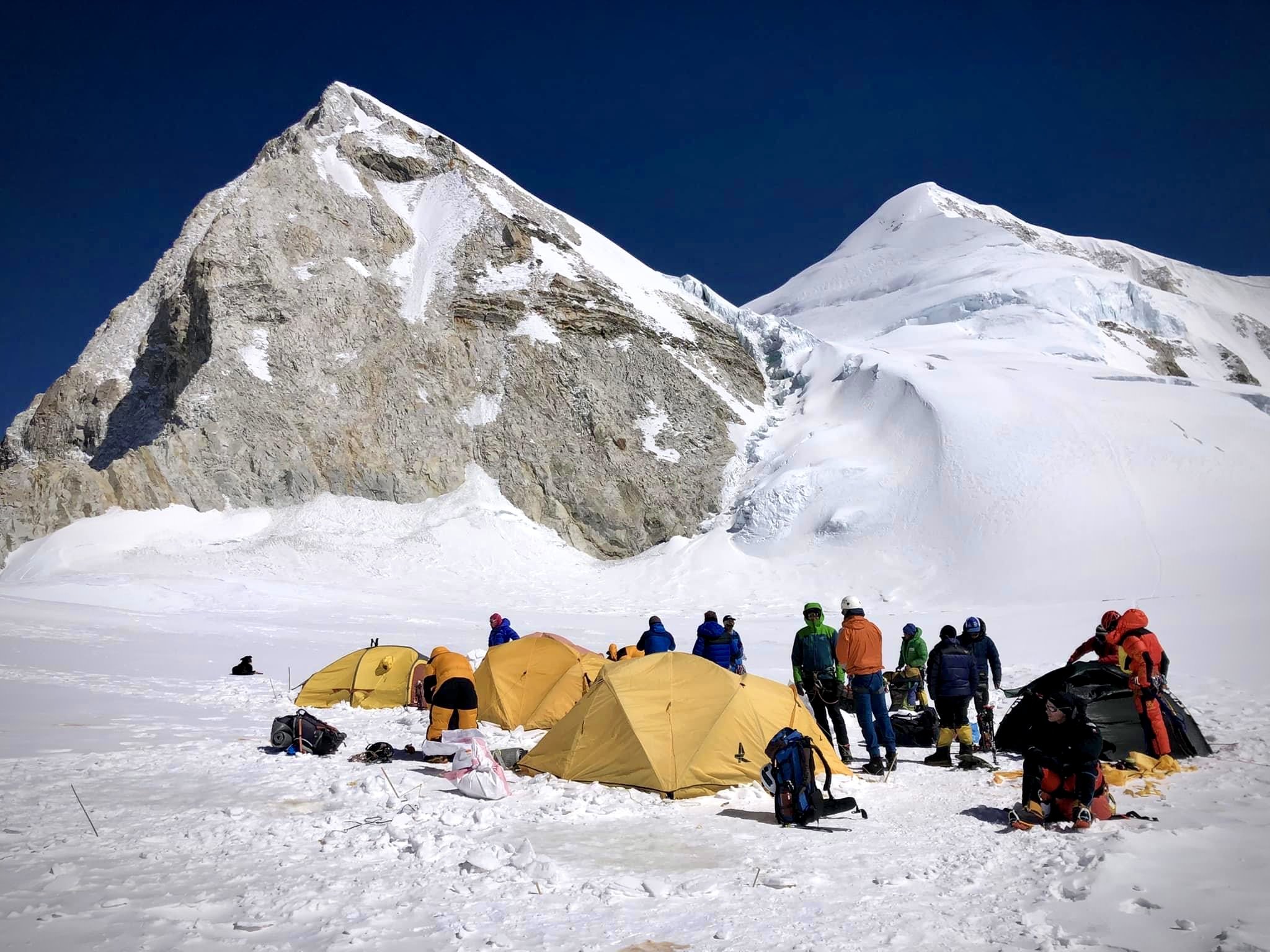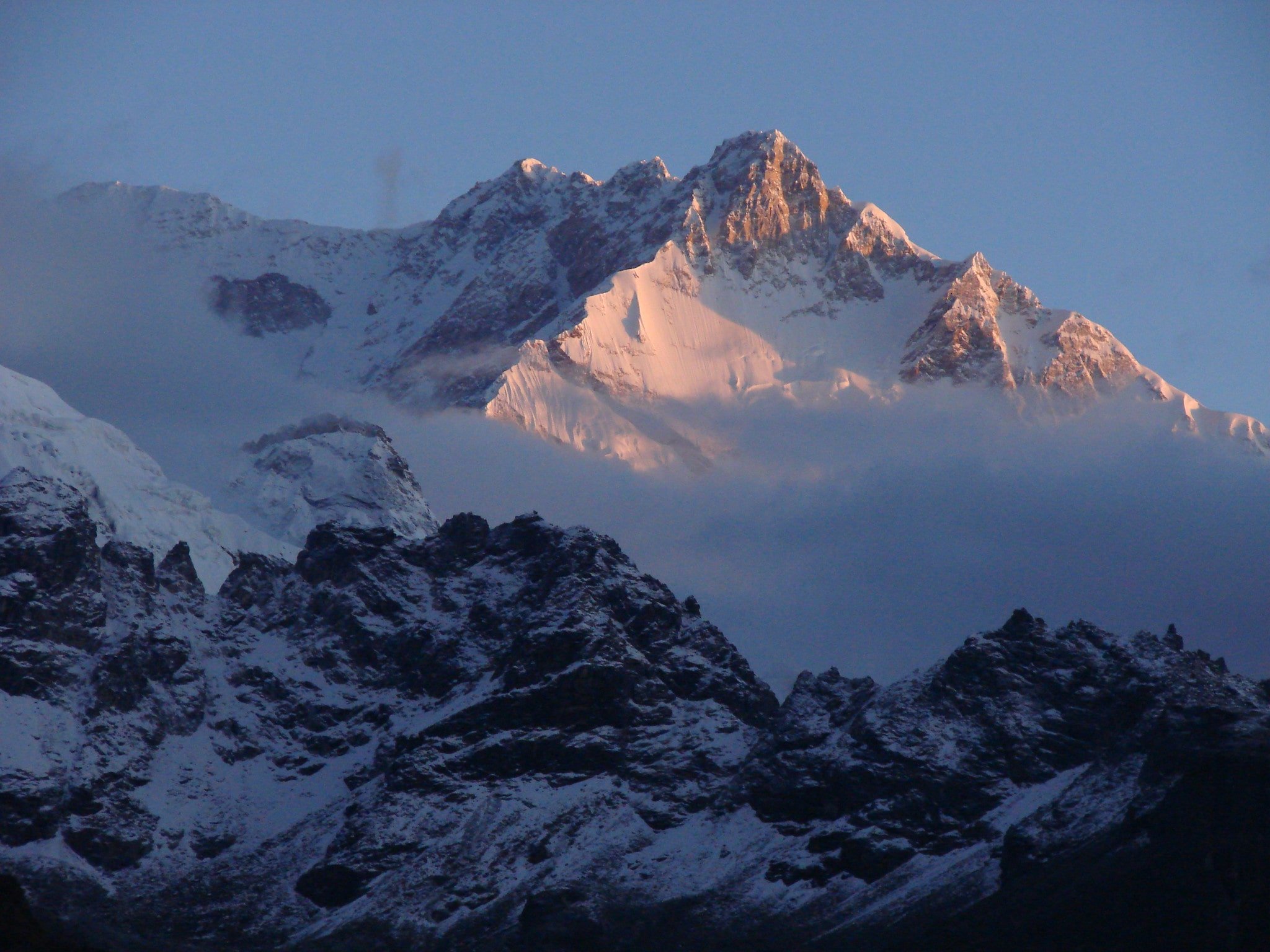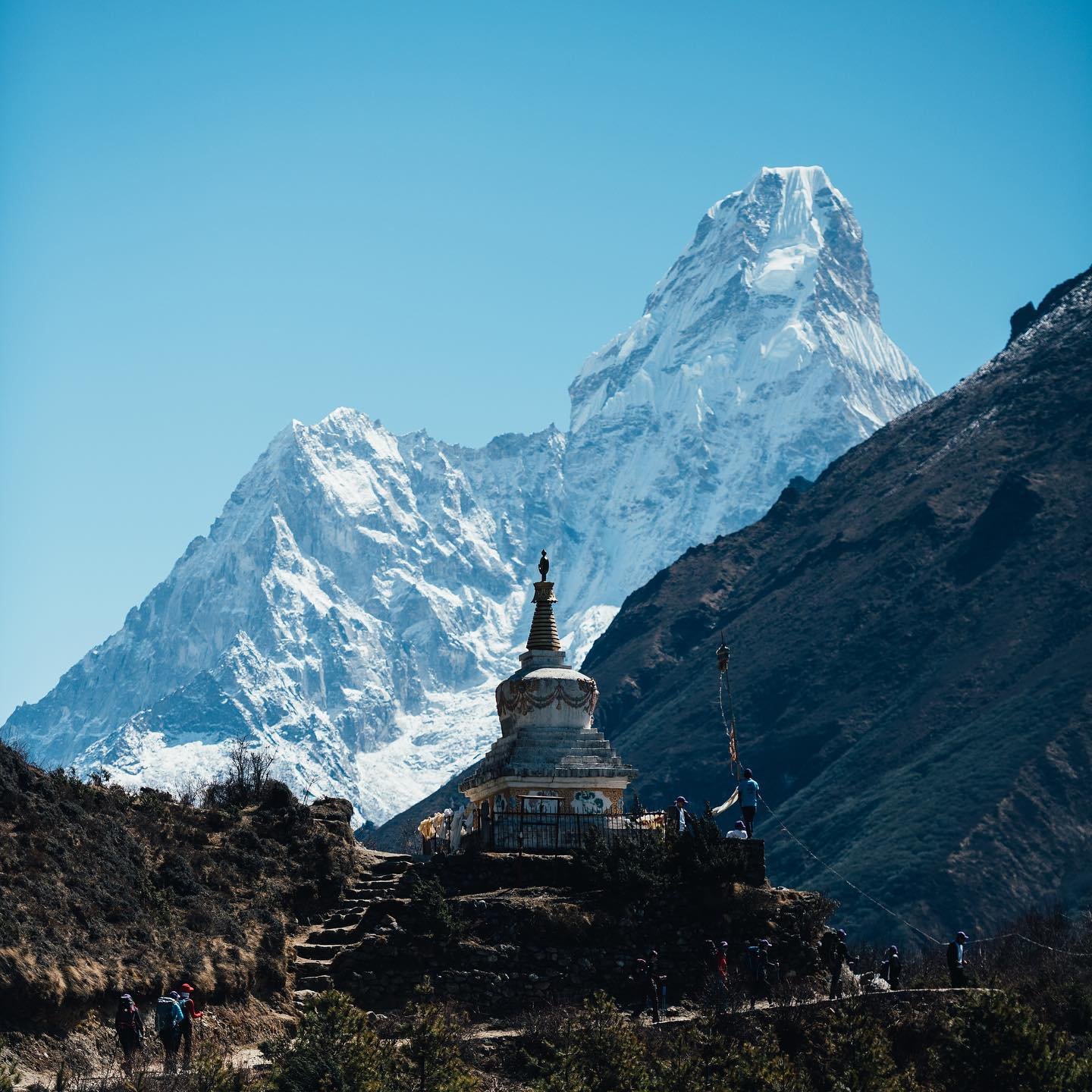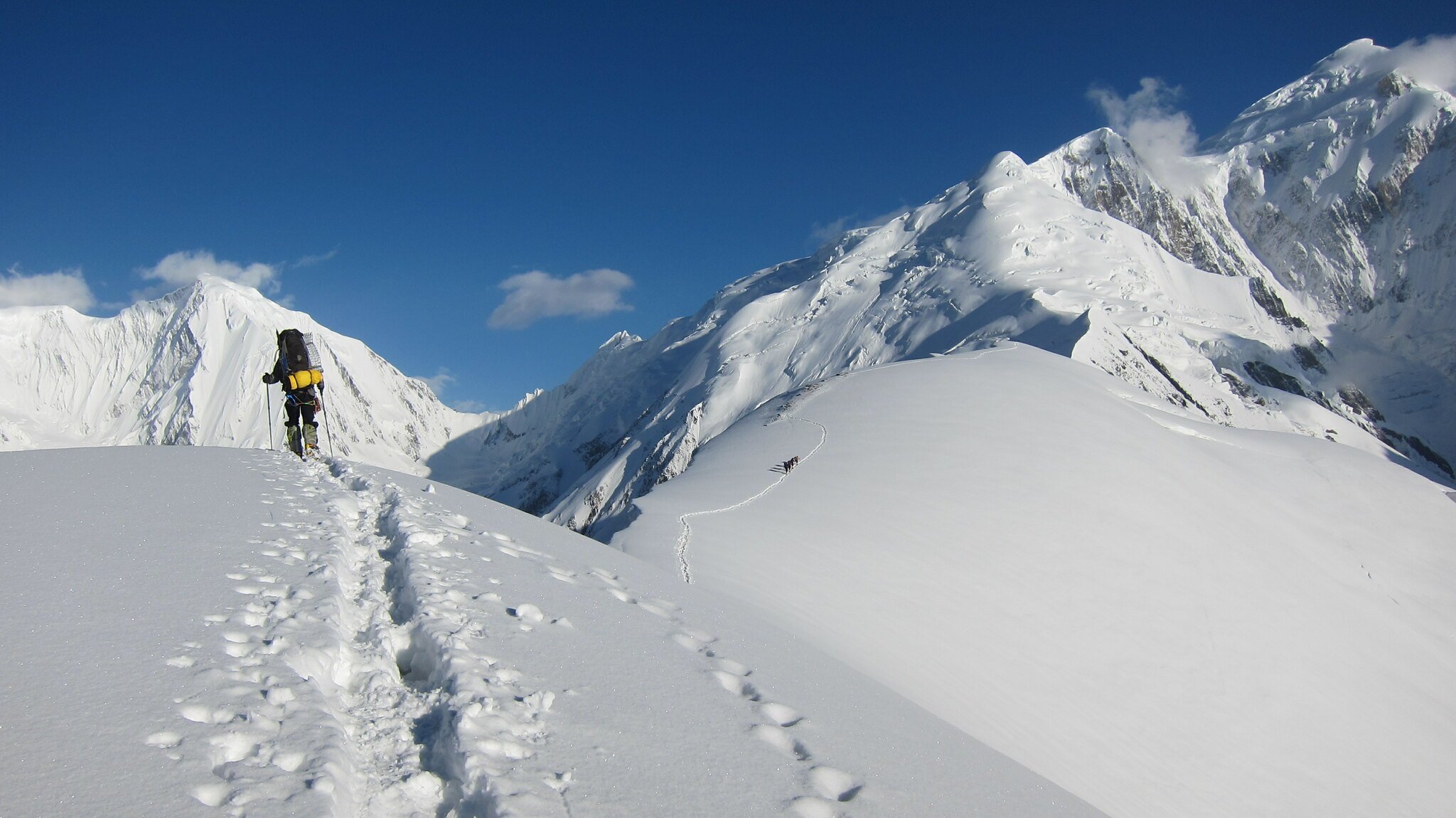Lenin Peak 7134M Expedition strategy - Namas Adventure
If you’ve been dreaming of summiting a 7,000-meter peak, Lenin Peak should definitely be on your radar. Situated on the border between Kyrgyzstan and Tajikistan, Lenin Peak stands at 7,134 meters, making it one of the most accessible summits in the world for mountaineers seeking a high-altitude challenge.
For climbers with prior experience on peaks between 4,000m to 6,000m, Lenin Peak is an excellent next step. It offers a mix of technical challenges and breathtaking landscapes, while being achievable with the right preparation and strategy.
Our Strategy for the Climb: Focus on Safety and Enjoyment
While Lenin Peak is considered one of the more accessible 7,000-meter mountains, it still poses some challenges. From harsh weather and crevasses to high-altitude conditions, the ascent requires careful planning and a solid climbing strategy.
Our approach is focused on gradual acclimatization, safety, and pacing ourselves through each stage of the journey. We’ve designed our route with the goal of ensuring every climber has a rewarding, successful experience. With this strategy, climbers will be able to tackle each stage of the ascent and have a strong chance at summiting safely.
The Journey Begins: Base Camp to Camp 1 (4,400m)
The adventure kicks off at the IMC "Pamir" base camp in the stunning Achik-Tash valley. After a day of rest and acclimatization, we’ll set off toward Camp 1, located at 4,400 meters. This first stretch takes you across the Lenin Glacier, where you'll navigate crevasses and snow-covered slopes. While the technical difficulty is moderate, it’s important to take it slow and allow your body to adjust to the increasing altitude.
The Rotation Phase: Preparing for the Final Push
Before attempting the final summit, acclimatization and building endurance are key. The rotation process involves climbing between IMC 'Pamir', Camp 1, Camp 2, and Camp 3, gradually gaining altitude, and then descending back to IMC "Pamir" for rest. This allows your body to adjust to the thinner air and prepares you for the final push to the summit. Climbers will make two or more rotations between these camps before heading to the summit. Each rotation helps climbers test their gear, optimize their techniques, and adjust to the altitude.
It’s essential to take this rotation phase seriously, as it maximizes your chances of success and safety on summit day. By the time we’re ready for the final push, you’ll be fully prepared.
Acclimatization: Home Peak or Yuhin Peak
Before ascending to Camp 2, we’ll spend two days preparing for the climb by making acclimatization hikes to Home Peak (4,750m) or Yuhin Peak (5,130m). These hikes will help your body adjust to higher altitudes and further prepare you for the ascent.
Camp 1 to Camp 2 (5,300m): Getting into the Groove
From Camp 1, we’ll ascend toward Camp 2, which sits at 5,300 meters. The terrain here involves crossing the dry Lenin Glacier and climbing long snow slopes. This section is challenging, but the scenery and the sense of progression will keep you motivated. By this point, we aim to give climbers ample time to acclimatize to the altitude and prepare for the more strenuous climbs ahead.
Camp 2 to Camp 3 (6,100m): The Big Push
From Camp 2, we will make our way to Camp 3 at 6,100 meters. This part of the journey will test your endurance, but the views of Razdelnaya Peak (6,148m) and the surrounding Pamir Mountains will make it worthwhile. From here, you’ll gain a new perspective on the Alai Plain to the north and the snow-capped peaks to the south. The climb to Camp 3 is physically demanding, but the summit ridge becomes visible, adding to the excitement of the ascent.
Return to IMC "Pamir" for Rest
After completing the rotation up to Camp 3, we’ll descend back to IMC "Pamir" to rest and allow our bodies to recover. This rest period is importance for ensuring that climbers are well-prepared for the summit push, allowing time for recovery and final adjustments.
Summit Push: The Final Ascent
Once rested and prepared, we’ll begin our summit push, following this progression:
- IMC "Pamir" to Camp 1
- Camp 1 to Camp 2
- Camp 2 to Camp 3 Finally, the most challenging part of the journey:
Camp 3 to Summit (7,134m): The Final Ascent
After completing the necessary rotations and returning to IMC "Pamir" for rest, climbers will be ready for the summit push. From Camp 3, the summit ridge becomes visible, signaling that the final climb is near. Depending on energy levels and weather conditions, climbers may choose to ascend in one go or set up an additional camp at 6,400 meters for a more gradual approach.
The final climb to the summit is demanding. It begins with reaching a pass through snow-covered slopes that are steep (about 50°) and exposed. As we continue to ascend, the slopes become less steep, and we navigate a few flatter sections. The steepest part of the climb occurs along the ridge, where we’ll install fixed ropes for safety. Once past this section, it’s a final push to the top. The summit of Lenin Peak offers sweeping views of the surrounding Pamir Mountains and distant peaks like Mustagh Ata and Kongur. Standing at 7,134 meters, you’ll be rewarded with a sense of accomplishment and unparalleled vistas. The summit is marked by a plaque of Lenin, adding a historical element to this epic adventure.
Descent and Reflection
After reaching the summit, it’s time to descend to Camp 3 to rest, then continue down to Camp 1 and ultimately back to IMC 'Pamir'. The last few days of the expedition allow time for reflection on your achievement, celebration with fellow climbers, and preparing for the journey home.
Why Join Our Lenin Peak Expedition?
Our Lenin Peak expedition is about more than just summiting the peak. It’s about enjoying yourself in the mountains, challenging your limits, and accomplishing something extraordinary with a team that cares about your success.
Whether you’ve tackled peaks like Kilimanjaro, Mount Elbrus, Khumbu 3 peak, Lobuche East or Island Peak or are looking for your 7000M challenge, Lenin Peak offers the perfect opportunity to test your skills and experience the majesty of the Pamir Mountains.
If you have any questions or are ready to join our next expedition, don’t hesitate to reach out. Contact us at bookings@namasadventure.com, and our team will be happy to help you on your journey.
Let’s go and explore the 7000ers
Live Your Story
Namas Adventure Team
Climbers Guide: Annapurna IV or Annapurna 4, 7525M
MOUNTAIN OVERVIEW
Name: Annapurna IV or Annapurna 4 (Link)
Elevation: 7525M/24688FT
Co-ordinates: 28°32′15″N 84°4′58″E
Crowd level: Minimum (Spring/Autumn, 0 - 20)
Difficulty grading: TD+/4 (Alpine/Fitness grading info)
Location: Annapurna region. Humde, Manang.
Parent Mountain: Annapurna massif
Acclimatisation Rotation: 1 rotation
Camps: 4 high camps
Summits: 1 Fore Summit / 1 Main Summit
Country: Nepal
ABOUT THE MOUNTAIN
Annapurna IV, standing at 7,527 meters, presents an ideal mountaineering challenge for climbers seeking a rewarding ascent with manageable technical requirements. Situated within the renowned Annapurna massif range, it occupies a prominent position between Annapurna II (7,937 meters) to the west and Annapurna III (7,555 meters) to the east.
Unlike its neighboring peaks, Annapurna IV offers a climbing route with fewer inherent dangers and a semi-technical nature, making it accessible to climbers with moderate experience levels. Within the Annapurna massif range, it is recognized as the least perilous and least technically demanding summit.
Despite its exceptional attributes, Annapurna IV remains relatively less frequented compared to other peaks in the region. However, its allure lies in its lesser-known status, offering climbers the opportunity for a unique and memorable ascent amidst the breathtaking Himalayan landscape.
HISTORY
Annapurna IV was first climbed in 1955 by a German expedition led by Heinz Steinmetz via the North Face and Northwest Ridge.
HOW TO GET HERE?
There is one main route to get to Annapurna IV Base Camp.
Via Humde village, Manang
Manang village, acclimatisation hike 3519M
Route to Annapurna IV Base Camp 4800M - 4850M
We highly recommend an acclimatization trek to Manang village at 3,519M, before hiking up to the AIV base camp. Climbers will navigate through lush pine forests and uphill terrain heading toward base camp. Climbers will have to hike up the steep hill and moraine to reach the Annapurna IV base camp situated at 4,800 meters.
Set against the backdrop of the majestic Annapurna massif, the Annapurna IV base camp offers a picturesque setting with panoramic views of Annapurna II, IV, and III. The flat surfaces of the hill provide ample space for setting up multiple camps, while nearby glacier lakes and streams serve as reliable water sources for expedition use.
Annapurna IV, Base Camp, 4800M - 4850M
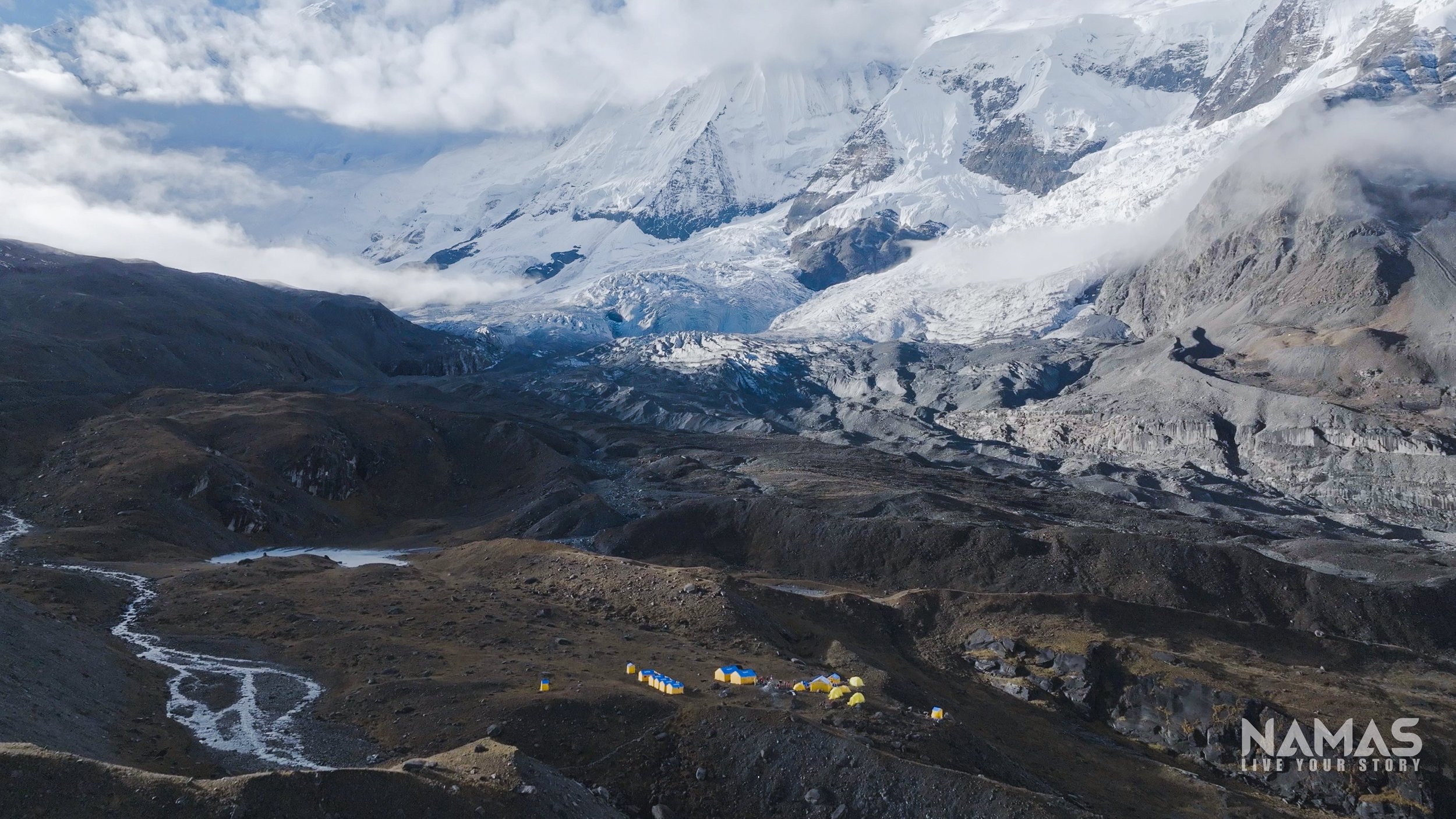
Route to Camp 1 5500M. 5 - 7 hours
Traversing the moraine glacier, climbers will ascend to the base of the mountain. The journey to Camp 1 entails a challenging ascent up a steep, rocky slope. To assist climbers, a fixed line will be established by the team, facilitating vertical climbs with inclines ranging from 60 to 80 degrees on sharp rock slabs. Negotiating this rugged terrain involves scrambling, jummaring, and traversing exposed sections of the mountain—a crucial initial technical phase of the ascent.
Expeditions conducted during the spring season should anticipate encountering a substantial amount of snow compared to expeditions in autumn.
Camp 1, 5500M
Route to Camp 2, 5500M - 5600M. 5- 6 hours
The ascent to Camp 2 commences with a challenging uphill climb of loose rocky terrain before climbers reach a designated crampon point. Here, team members secure their crampons in preparation for an 80-degree steep climb across icy and snowy terrain.
Climbing towards camp 2, the route carefully avoids areas prone to avalanches, it skirts the left side of the mountain, where avalanche activity is more common. Despite initial apprehensions, climbers can rest assured that the climbing route is designed with safety in mind and is not susceptible to avalanches. Although a few crevasses may be encountered along the way, they are manageable, either by navigating around them or making calculated leaps across. It is essential for climbers to remain securely attached to the fixed line throughout the ascent.
Offering breathtaking views of the Annapurna wall and the expansive glacier, this climb presents a picturesque and rewarding experience amidst the awe-inspiring scenery of the Himalayas.
Annapurna IV Camp 2 (5500M - 5600M)
Camp 2, 6500M
Situated on a compact, level expanse of the mountainside, this camp offers protection from strong winds originating from the north and northeast sections of the mountain range. Prepare to be captivated by the breathtaking panorama unfolding before you. From this vantage point, the majestic peak of Manaslu, towering at 8,163 meters, commands attention in the distant horizon. Additionally, the formidable wall of Annapurna II dominates the landscape, extending far into the leftward vista, where the impressive silhouettes of Himchuli and the Chulu ranges adorn the skyline..
View from camp 2. Annapurna II 7937M and Manaslu 8163M in the far distant.
Route to Camp 3 (6 - 7 hours)
Upon departing from Camp 2, climbers will immediately face a challenging ascent up the headwall, marked by a steep incline. Following the climb past two prominent boulders, climbers will encounter a sizable crevasse directly ahead. While manageable, this crevasse presents a notable obstacle, with plans for ladder crossings in future expeditions should the opening widen.
Upon successfully navigating the crevasse and ascending another incline, climbers will find themselves traversing across a vast expanse of snowfield. After approximately 1.5 to 2 hours of rigorous climbing, Camp 3 comes into view, offering a welcome respite amidst the stunning mountainous terrain.
Camp 3, 6600M
Positioned on the expansive shoulder of the mountain, Camp 3 offers 360 views of the surrounding mountains. Fishtail (Machhapucchre) mountain is directly to the north-east along with Annapurna 1 and south. With a sweeping view of a significant portion of the mountain directly ahead, climbers have the option to strategize their summit route either along the mountain's slopes or via its southern aspect. Given the complexity of this vast slope and the absence of marked routes typical of more commercialized mountains, the presence of experienced leaders and skilled route setters is imperative.
Navigating this terrain demands a high level of expertise, as the route may not be easily discernible, and few climbers are likely to traverse it. Additionally, certain areas may pose a risk of avalanches, underscoring the importance of proficiency in navigation and avalanche detection. With the guidance of seasoned professionals, climbers can confidently navigate the challenges of Camp 3 and proceed with their ascent toward the summit.
Annapurna IV Camp 3 6600M
The chaos to navigate to make it to the summit.
Route to Camp 4, (6 - 8 hours)
Embarking from Camp 3 towards Camp 4 involves traversing snowy fields and negotiating uphill slopes before descending across snow fields. The subsequent grueling ascent presents a continuous uphill climb toward the mountain's shoulder, requiring precise navigation skills from route setters.
This route offers teams two challenging options: a direct push to the summit from Camp 3, with an overnight stop at Camp 4 on the return, or a camp at Camp 4 followed by a summit push before returning to Camp 3. Camp 4, positioned at 7000 meters altitude on a flat surface, demands extra caution due to potentially windy conditions.
Camp 4 can be on the setup on the shoulder (middle) of the mountain.
true Summit of Annapurna IV 7525M to Camp 4 (7000M). 10-12 Hours
Climbers need to prepare themselves mentally for a lengthy, steep, and arduous journey to the summit. The ascent from Camp 3 to the summit and back typically spans 12-14 hours. Following departure from Camp 3, climbers face a daunting 1000-meter climb characterized by its steepness and length, making it a formidable challenge.
Safety measures include the installation of fixed lines along perilous and overhanging sections of the mountain walls. Weather permitting, summit views offer a breathtaking panorama encompassing the entire Annapurna massif range, including Annapurna I, II, III, Gangapurna, and Tilicho Peak, as well as prominent peaks like Manaslu (8163 meters), Machhpucchre, Ganesh Himal, and Dhaulagiri.
Upon completion of the summit, the objective is to return safely to Camp 4. Camp overnight, rest for a night and then an early downhill morning to base camp, which is expected to be a long 8-10 hours descend from the mountain, bringing our expedition to a conclusion.
Namas Adventure team members at Annapurna IV 7525M true summit. This one will be for life time memories. What a climb and pure test of grit, will and mental toughness.
Watch full Annapurna IV 7525M Expedition video
Feel inspired to embark on a 7525M remote expedition with not many climbers? Let us be your guide to remote mountain peaks in the Himalayan region, including the challenging Annapurna IV at 7525 meters. Our specialized team excels in safely accessing and navigating these pristine mountain territories, opening up new possibilities for exploration and discovery.
Visit our website for more information on our Annapurna IV expedition and our range of international expeditions. For booking inquiries, reach out to us at bookings@namasadventure.com.
Unleash the explorer within you, and climb where less has been.
LIVE YOUR STORY - NAMAS ADVENTURE TEAM
When is the best time to climb Himlung Himal? Spring or Autumn? - Namas Adventure
Climbing the final summit ridge at Himlung Himal 7126M
Himlung Himal is one of the best options to climb a 7000M+ peak in the remote corner of the Annapurna region. This 7000M peak expedition is classed as one of the most accessible, safest, semi-technical climbs with a higher summit success rate at 7000M peak mountain expeditions.
This peak is suitable to climb during both seasons but more success stories have been officially recorded of the autumn season’s climb. See our blog post on Baruntse or Himlung Himal for data from 2017 to 2020 (Link). For those interested in their first 7000M peak expeditions, we often get asked when is the best time to climb Himlung Himal?
With years of running expeditions and gathering local information passed on from our guides, who have been climbing year in and out, and collecting data from local databases, we would say it depends on your preference for climbing a mountain in different conditions. The great news is that Himlung Himal is suitable to climb during late spring and during early to mid-autumn. Here, we aim to lay out the conditions during spring and autumn so that you can choose to climb in the season you prefer.
What is the difference between Spring & Autumn climb? 🧗
There are fewer climbers during the spring season compared to the autumn season.
More snow during spring compared to autumn climbs
A high probability of wind speed picking up and extreme freezing temperature drop during late autumn.
The spring season sees a longer daylight duration compared to the autumn season.
Late April to May and Mid-September to October are the best time to climb.
Autumn sees more stable weather compared to the spring season.
In spring (late April - May) some of the winter snow will have melted in the mountains making it favorable to climb. Himlung Himal is known to have more snow (more so during spring), so do not underestimate the grit you will have to go through when climbing this peak. Weather can never be guaranteed in the mountains and you should expect some weather-related disturbances during your climb even though this is the best time to climb. If you are one who enjoys a bit of an extra challenge at extreme altitude peak climbing then spring expeditions might your pick.
Every mountain definitely tests your patience especially when things don’t go according to the plan and teams will have to improvise and wait out for climbable conditions. Spring sees fewer climbers than other peaks (Everest/Lhotse excluded) compared to autumn. When spring does open up with a clear weather window it is one of the best times to climb in Nepal. Oh! and not to forget you and your team will have the whole of the mountain to yourself. There is hardly any team in Himlung Himal during the spring season.
Autumn (Mid September - October) is the next time to climb Himlung Himal. A number of teams can be expected during this season compared to the spring season. After Manaslu 8163M teams are focused on either Himlung Himal 7129M, Baruntse 7129M, or Ama Dablam 6810M (the most teams). Guides have reported that as soon as November hits high winds start to pick up in the mountain and this has been the case for the past several years most summits have been in October or in the first week of November.
Himlung Himal has the highest summit records during the autumn season when compared amongst all the commercial 7000M+ expeditions that operate in Nepal. So under good to perfect conditions and the mountain not being super-difficult to climb, technically, Himlung Himal is the best 7000M+ expedition to climb during autumn.
Conclusion
Whichever is your preferred season, climbing Himlung Himal 7129 is an amazing 7000M+ expedition to be undertaken. Spring hosts fewer climbers when compared to autumn and conditions are suitable to climb during both seasons as mentioned above. If you are up for a challenge and prefer to see fewer climbers during the expedition then spring departures are for you. If you are comfortable with some amount of teams being in the mountains then autumn is still a great time to climb this 7000er peak. The thrill and challenges of climbing a remote Himalayan peak are guaranteed. You as a climber choose your climbing condition and the thrill of a great climbing experience is guaranteed. Either way, it is an amazing peak to climb and an accomplishment of a lifetime.
Let’s go, and climb Himlung Himal and other peaks around the world.
Go. Live Your Story.
Question.
Which season do you plan to climb Himlung Himal? Please comment below, we’d love to hear from you.
We organize Himlung Himal 7129M peak expedition every year during spring and during autumn. Planning to climb a 7000M+ peak one day? Whatever your climbing goal is drop us an email. Our team will be glad to have you onboard and together we shall achieve the summit and enjoy the climbing experience. Our team is here to assist and make your climb in the Himalayas an enjoyable, accessible, and comfortable one.
Baruntse 7129M or Himlung Himal 7126M which 7000M+ mountain peak to climb? - Namas Adventure
Baruntse and Himlung Himal are perfect intermediate level and semi-technical peaks to climb at 7000M level in the Himalayas. Whatever your goals for climbing a 7000M extreme altitude expedition be, a stepping stone to an 8000er peak or climbing simply climbing a 7000er mountain peak, we highly recommend these two peak expeditions. (Putha Hiunchuli 7246M is another great option)
Both expeditions are not crowded as the 8000er expeditions (Everest/Lhotse during spring & Manaslu during autumn). Between the two expeditions, Himlung Himal has seen slightly higher climbers compared to Baruntse. (2021 Autumn, Himlung Himal 77 - 90 climbers & Baruntse 20 - 25 climbers). So, you can certain that there won’t be a crazy amount of climbers during your expedition. Having said that, it is always good to have some number of team/s in the mountain. You can never be sure when an event turns out wrong in the mountains. Every day we are playing with the forces of nature. Balance is key.
Learning from past summit data, the Himlung Himal expedition has a higher rate of summit success compared to the Baruntse peak expedition where there are several summits during the autumn season compared to 0 summits during the spring season (commercial route). Let’s look at the data from the previous 5 years of Baruntse 7129M and Himlung Himal 7126M successful summits. (commercial expeditions). Source “Himlayan Database”
Successful summits, BARUNTSE 7129M VS HIMLUNG HIMAL 7126M
So, coming to the question of which 7000M peak I should climb?
Our answer is it depends on your preference. What is it that you want from your adventure? If the summit goal is important to you (no mountain summit is 100% guaranteed) then Himlung Himal 7126M has a better odds of making it to the summit than Baruntse 7129M and is technically less challenging.
Situations change in the mountains, you never know when the next dangers pop out in the mountain, or the hazard that was there before may not even exist. Weather is a huge factor during your high camp days. You may have a clear window for the next 7+ days or it might be pouring snow and low visibility, windy for an extended period of time. Being safe and returning home safely should be your primary goal. Whatever the circumstances, you should be open to all possibilities of success or failure. What is guaranteed is a raw and thrilling Himalayan adventure in your life memoir.
With the insight data from previous years, if you would like to choose any of the 7000M expeditions mentioned above then our team at Namas Adventure is here to assist and welcome you to take on your adventure of climbing a 7000M mountain. We organize the expedition during both seasons. For yearly mountain updates and summit success, hazards in the mountains and to be part of our team on 7000M mountain expeditions or other mountaineering expeditions, please email us at - bookings@namasadventure.com. Our team will be there to assist you on your next adventure of a lifetime.
Let’s go and explore the 7000ers.
Live Your Story
Namas Adventure Team
Mountain expeditions in Nepal during the autumn season - Namas Adventure
Planning your next 6000M, 7000M, or 8000M mountain expeditions in Nepal during the Autumn season?
September - November (autumn in Nepal) is another best time to plan your Himalayan adventures. After the spring headlines of Everest, Lhotse, and Makalu stories, autumn awaits to write new chapters and records in other Himalayan peaks.
p.s. - Everest or Lhotse expedition is not organized during the autumn season. Why do you ask? There is the financial side with almost no teams to cover up for Khumbu icefall doctors fees and the weather window is generally very short.
Manaslu 8163M (Late August - September) and Ama Dablam 6810M (October - November) attract the majority of the climbers but the way we see it there are other amazing peaks that can be climbed and explored. Here are our suggestions
7000M Expeditions
Baruntse Expedition 7129M
Remote, Raw, and Rugged. Semi-technical climb in nature, Baruntse peak is one of the 7000er mountains that is accessible to climb during autumn. The knife ridge to the summit is not for the faint-hearted. Perfect 7000M expedition that gives you a solid feel of proper mountaineering (classic and alpine style) and best of all there aren’t many climbers. No traffic and one we love taking upon.
Join us here during autumn climbs (October - November)
A classic 7000er climb in the Annapurna region. Remote, safer, accessible, and less technical with a high chance of summit success. Expect some long climbing days, particularly on summit day. A moderate amount of teams are attempting Himlung during the autumn season.
Join us for Himlung Himal 7126M expedition (September - October - November) every year.
ANNAPURNA IV 7525M
Breaking above the 7500M zone, Annapurna IV 7527M is the perfect mountaineering objective for climbers who do not want to avoid crowds/traffic to prepare for their Everest or other 8000M peak expeditions. Annapurna IV is part of the great Annapurna massif range, standing tall between Annapurna II 7937M/26040FT on the western side and Annapurna III 7555M/24787FT to the eastern face. The climbing route has fewer objective dangers and is relatively a semi-technical climb.
Far away from the sight of Everest and if you want to have a feel of the classic mountaineering expedition and raw-pristine moments then the far west expedition to Putha Hiunchuli 7246m in Nepal surely won’t disappoint.
You are a pro-seasonal high altitude skier and want to up your shredding game? This peak provides you with a perfect line. We venture into Putha Hiunchuli every 2 to 3 years. Check out our next departure dates to Putha Hiunchuli on our page.
8000M Expeditions
Manaslu 8163M
Manaslu, the mountain of spirit, is the most climbed 8000M+ mountain during the Autumn season. Now with the true summit finally becoming clear to all the climbers, the final 100M traverse to the summit does not get easier. Manaslu is also considered one of the easiest mountains at 8000M level.
We organize a Manaslu expedition every season, join our ever so small and fun-loving team, not to forget to the true summit.
Dhaulagiri 8167M
Approaching Dhaulagiri 8167M
Located in the central west of Nepal, Dhaulagiri 8167 M mountain is another 8000er expedition that is organized mostly during the autumn season. Dhaulagiri attracts a handful of climbers during the autumn season. This is the world’s lucky 7th highest mountain.
Check out 8000M expedition pages for upcoming Dhaulagiri expeditions.
Kanchenjunga 8586M
Kanchenjunga 8586M
Mount Kanchenjunga 8586M is the final 8000M on the eastern flanks of the Himalayan belt. It sits right on the border of Nepal and India (Sikkim). A handful of expeditions are organised every year and some summits have been recorded during autumn season too.
6000M Expeditions
Ama Dablam 6810M
After the Manaslu climb, almost 90% of the team is focused on the Ama Dablam. Be it to summit this peak or to strategize with next season’s Everest climb. Either way, expect a decent crowd of climbers at Ama Dablam.
Join us at Ama Dablam every autumn and possibly during early winter too. For the ones that can brave the cold.
If you want to escape the gatherings of climbers at Ama Dablam and instead climb an equally challenging or may even be a tougher peak in the Khumbu region then Cholatse is a perfect mountain to climb. Do not underestimate this mountain because it does not boast higher but the climbing routes are second to none. Climbing on a long exposed knife-edge ridge and climbing ice headwalls are some amazing feats to take on at Cholatse.
Plenty of crux and not forget the ever visible Gokyo valley during your entire climbing period. Join us at Cholatse every year during the autumn season.
Note - With Everest/Lhotse expedition not operating during the autumn season, most of the certified guides (350 - 400) are not occupied and are raring to go and help climbers achieve their dream adventures in other mountain peaks.
Since autumn is another big season to achieve your dream climbs in Nepal, are you planning any of the above-mentioned mountaineering adventures? We organize, all-inclusive expeditions during the autumn season and would love to welcome you onboard our teams. Unlike others, we organize a team of max 8 small and a compact teams, which enables us to plan swiftly and have an intimate group during our expeditions.
Join us on our 6000M, 7000M, or 8000M expeditions during autumn in any given year. Let’s go on your dream adventures.
Live Your Story
Climbing your first 7000M mountain peaks. Safer, easiest and high success rate - Namas Adventure
What is the easiest 7000M peak to climb, especially for someone looking to transition from 6000M peaks before attempting an 8000M mountain? Which 7000M peak offers the highest success rate for climbers?
Climbing 7000M peaks can be a great way to gain valuable experience and improve your skills before tackling higher mountains. These peaks are often less crowded than their 8000M counterparts, such as 🏔Mount Everest, K2, Manaslu, and Makalu, and provide a chance to test your abilities in a more remote setting. It is important to have a solid foundation of experience and proven climbing skills before attempting these peaks, and if you have any doubts about your readiness, it is recommended to discuss your experience level with a professional guide or expedition company.
For those interested in high-altitude mountaineering, it is important to note that there are no easy peaks to conquer. It is crucial to have previous experience climbing above 4000-6000 meters before attempting a 7000M peak. These expeditions will provide the necessary knowledge and understanding of what it takes to climb larger mountains, both physically and mentally. At the 7000-meter level, the difficulty and technicality increase significantly, so it is important to be well-prepared and able to handle the challenges that come with these expeditions.
To qualify for a 7000-meter peak expedition, it is recommended to have completed at least two climbs of 6000 meters or higher, such as Lobuche East, Island Peak, Chulu West, or Mont Blanc. These experiences will help you understand how your body and mind respond to high-altitude environments and allow you to reflect and optimize your training for future challenges.
If you are planning a 7000-meter mountain expedition, there are several entry-level options available that offer semi-technical or technical climbing routes and are considered safer without unreasonable dangers. These expeditions can be an excellent goal for intermediate to advanced-level climbers.
Himlung Himal 7126M, Nepal
Himlung Himal 7126M, will be our first recommendation when it comes to 7000M+ peak expedition. This peak has the highest summit success records to date and is considered the easy/safest 7000M expedition in Nepal.
Pre-requisite requirements (at least one or more): Kilimanjaro, Mt. Elbrus, Lobuche East & Island Peak, Chulu West, Khumbu 3 Peak expeditions, Aconcagua, Mt, Blanc. (Similar 4000M - 6000M peaks or higher)
This peak is a popular choice for intermediate climbers seeking a challenging yet accessible mountaineering experience in the Annapurna region, located near the border of Nepal and Tibet. The best time to tackle this mountain is during the late spring or autumn when climbing conditions are optimal and the size and support of other teams are favorable.
This expedition involves ascending through a series of 2-3 high camps, with no intermediate peaks for acclimatization. Climbers can expect plenty of snow on the mountain, which is known for its fresh powder. Despite its remote location, there may be a few other smaller teams and climbers present at base camp and along the route. If you are interested in tackling Himlung Himal, be sure to read more about this expedition."
Bonus article - Check our article on the success rate of Himlung Himal vs Baruntse. (link)
Lenin Peak is another 7000M peak that is considered an easy, accessible, and non-technical climb. This peak sits at the border between Kyrgyzstan and Tajikistan. The only factor that hinders a lot of the expeditions in this part of the climbing world, is the unstable and uncompromising weather patterns. Most commercial expeditions are planned during the summer season (June - August).
This expedition does attract a handful of crowds so, if you want expeditions with lesser crowds/teams then the above-mentioned expedition will be the better alternative.
Pre-requisite requirements (at least one or more): Lobuche East & Island Peak, Chulu West, Khumbu 3 Peak expeditions, Aconcagua (Similar semi-technical 6000M peaks or higher)
Putha Hiunchuli 7246M, Nepal
Putha Hiunchuli 7246M (Dhaulagiri VII) can be found in the far western isolated part of Nepal. Putha Hiunchuli is another 7000M peak suitable for intermediate/advanced level climbers, which is a semi-technical climb without unreasonable hazards of avalanches and fewer crevasses in the climbing route. This mountain is best climbed during the autumn season due to the more stable snow conditions. The expedition involves three high camps and long stretches between camps. Putha Hiunchuli is known for having fewer dangers and wide plateaus, making it a popular choice for advanced-level off-piste skiers and snowboarders. However, logistics and infrastructure development in this region can be challenging compared to other expeditions. If you are an intermediate to advanced-level climber looking for a unique mountaineering experience, Putha Hiunchuli may be the perfect fit for you.
This is another easy and safest 7000M peak to climb but the only issue is their logistics and having enough team members for the expedition. Learn more about the Putha Hiunchuli expedition.
Pre-requisite requirements (at least one or more): Lobuche East & Island Peak, Chulu West, Khumbu 3 Peak expeditions, Aconcagua (Similar semi-technical 6000M peaks or higher)
Spantik 7026M, Pakistan
Spantik 7026M, is a popular choice for many climbers seeking a 7000M expedition in Pakistan. Also, famously named as Golden peak, Spantik is located in the Gilgit-Baltistan region. This peak expedition is accessible and can be a great 7000M introductory climbing during summer (June - August). This is another safer and semi-technical expedition to undertake, especially if you are planning your first 7000M expedition.
Pre-requisite requirements (at least one or more): Kilimanjaro, Mt. Elbrus, Lobuche East & Island Peak, Chulu West, Khumbu 3 Peak expeditions, Aconcagua, Mt, Blanc. (Similar 4000M - 6000M peaks or higher)
The journey to the base camp takes about 3 days of the trek. This expedition consists of 3 high camps with one or two rotations so that climbers are well acclimatized before making the push for the summit. From the summit, amazing views of the Hindu Kush and Karakoram ranges are seen with K2 and Broad peaks on sight.
Are you considering climbing your first 7000M peak as part of your mountaineering journey?
It is important to ensure that you have the necessary experience and preparation before attempting a climb of this magnitude. Inadequate preparation can not only jeopardize your own safety, but also that of your guides and team. Our team has a range of 7000M peak expeditions available in the Nepalese Himalayas and we are working on expanding our offerings to include summer expeditions in India and Pakistan in the future. Let us help you gain the necessary experience and skills to successfully reach the summit and continue on your mountaineering journey.
Go challenge greater things. Commit and finally take on that dream adventures you have always been planning. Life is too short to live with regrets. See you in the mountains. 🙂🏔🙏🏼
Namas Adventure Team
Live Your Story


